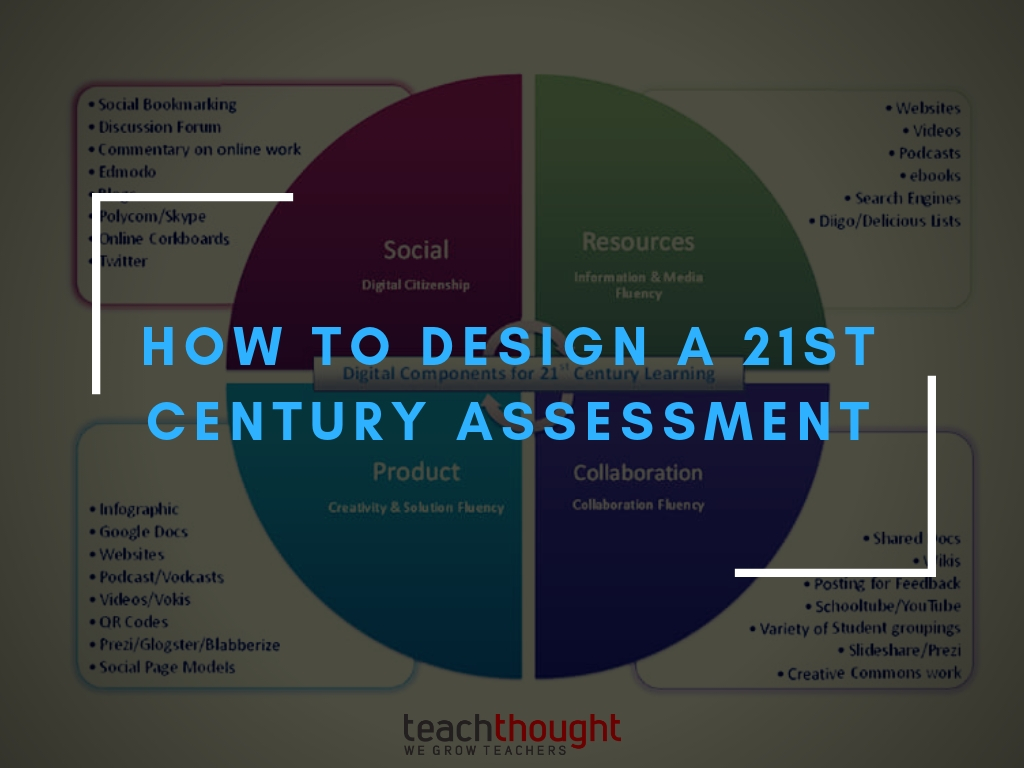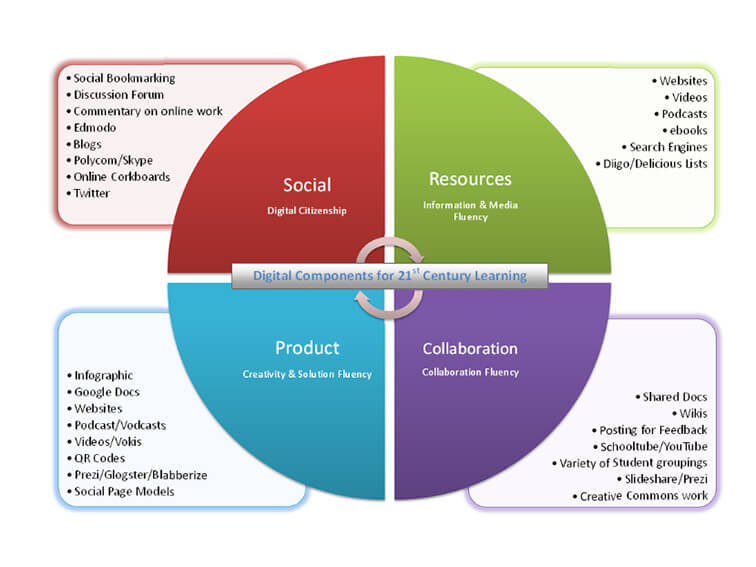
How To Design A 21st Century Assessment
by Mike Fisher
This post has been updated and republished
Contemporary curriculum design involves multiple facets: engaging 21st Century skills, using digital tools, collaborating with others around the globe, performance tasks, and more. Getting these design elements into a teacher’s current curriculum demands that teachers create professional habits around Replacement Thinking.
In my book Digital Learning Strategies, I describe four considerations for Replacement Thinking around assessments. In a nutshell, those considerations include:
- Students must demonstrate what they’ve learned. Whatever they create with digital tools should still represent what students were to learn. The assessment shouldn’t tell you more about their use of a tool than it does about the student’s work using the tool.
- Students should demonstrate content proficiency and sophistication. Their new product should reflect the content knowledge that they’ve learned and the multiple cognitive zones they participated in during the learning process.
- Students should be frequently reflecting on their choices. Students should be able to articulate and defend their tool choices, content inclusion, and degrees of audience interaction and how those choices affected the resulting product.
- Students must give credit where credit is due. They should know about copyright, Creative Commons licensing, and how to search for and use appropriate content, giving attribution for the media resources they use.
And while assessments are the focus of this blog post, replacement thinking can be applied across the curriculum: in instructional strategies, classroom activities, or in formative data collection using tools such as Kahoot, Socrative, or Google Forms. To help you start thinking about Replacement Thinking, I’d like to offer the following action steps to bring more contemporary ideas into your own professional practices:
Action Step 1: Stop thinking technology first.
Instead, use the best tool to support learning (e.g., feedback, performance, knowledge, creativity, etc.) The task should drive the tool(s) dependent upon what the students need to do for learning. That might be to pick up a pencil, read a print text, FaceTime their grandma who happens to be a veterinarian in Denmark, log onto a library database, send a Tweet to find an expert around a topic they are learning about, etc.
The tools support the learning, they are not, in an of themselves, the learning objective. My friend and mentor Heidi Hayes Jacobs often shares a metaphor about “Crayon Labs” in schools. We don’t plan to use crayons, they are just an always available option. Computer Labs and Digital Devices are the same. They are tools in a classroom toolbox and are always available.
Action Step 2: Give students authentic choice in how they will demonstrate their learning.
Part of an educator’s charge in the 21st Century is taking what we know about good instruction and apply it to today’s contemporary kid. We’ve done decades of research about how best to teach children and much of the research intersects at instructional methods that allow for personalization of the learning process.
Kids think differently, perform differently, have unique experiences, and have different ideas around what engages them. We can standardize tests from now until forever but we can’t standardize children. In fact, we should be seeking out ways to develop their unique skills and perspectives for the sake of rules for engaging students and that means offering choices in learning products, particularly if those learning products can be created in the myriad tools available online and on digital devices. (So long as the task is valued over the tool!)
Action Step 3: Help students seek feedback from other students, other educators, and experts in the field.
Feedback is more powerful than grades; Let students learn to amplify.
Traditional education is at a crossroads. There are so many things that impact the practice in a contemporary classroom and one of those things is our socially acceptable, decades-old practices around grading, much of which perpetuates desired behaviors over real learning and a punitive system of disparate generational values. In this day and age, grades are more likely to result in roadblocks to learning rather than motivating students to achieve. So how do we grow our students without grading them?
We offer them feedback about their work in the form of conversations and questions and constructive criticism. We publish unfinished drafts of their learning products online and solicit learning feedback from multiple audiences. We habitually amplify student work from the classroom to the world and seek perspective analysis from other students, other educators, and experts in the field.
We teach students to consider suggestions and improve their work. This also opens up cans of worms about authenticity and work worth doing. Do we want school to be a graded check-off list of the way we’ve always done it, or an experience that makes our students world-ready inquisitors ready to solve unique problems?

Action Step 4: Provide always-on, asynchronous access to that which is being assessed.
Everything. All the time. Access (and equity of access) is a priority cornerstone in the contemporary classroom. Access to print and digital resources is essential. Kids don’t need to come to school in order to be vessels we fill up with knowledge, that can look up anything on the Internet. School needs to be the place where knowledge is evaluated now–the how’s and the why’s are so much more important than the what’s–but the what’s have to be available at all times for every student.
The task of the contemporary teacher is to help students learn to take what is now ubiquitous (knowledge), learn to filter it for relevance and quality (critical thinking), and use it to learn, grow, and demonstrate 21st Century Skills (communication, collaboration, creative problem solving – from P21.org).
This can only happen with 24-7 access to all forms of knowledge and that also means having some real conversations about what we filter in schools. We need to think about our end goal. Is it to transfer knowledge? Is it to teach students to think? Is it to instill a passion for attaining goals? Do we want our students to be really good at Trivia Crack and Jeopardy! or do we want them to have a toolbox of opportunities that allows them to solve unique problems?
Contemporary instructional practice is about letting go of past ideals. Contemporary curriculum design is about inviting students to the design table and allowing them to co-create the learning experience. We should be seeking the sweet spot of learning, where the 21st Century tools and practices enhance the lesson, but is not the lesson itself.
Download a free copy of Mike Fisher’s book, Digital Learning Strategies: How do I assign and assess 21st-century work?, courtesy of Mike and ASCD as a limited-time offer for Connected Educator Month (CEM) 2015. ASCD is leading the CEM theme, “Innovations in Professional Learning,” and will be sharing free and discounted resources all month. Additionally, you can get ASCD’s assessment resources, aligned with the “Innovations in Assessment” CEM theme led by NCTE.
Mike Fisher is a former teacher who is now a full-time author, consultant, and instructional coach. He is the author of Digital Learning Strategies: How do I assign and assess 21st Century Work? and the co-author of Upgrade Your Curriculum: Practical Ways to Transform Units and Engage Students, both published by ASCD. You can now pre-order his new book, Ditch the Daily Lesson Plan: How do I plan for meaningful student learning? His website is The Digigogy Collaborative and he can also be found on Twitter as @fisher1000; image attribution flickr user TeachingJedi
